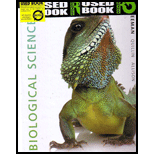
Concept explainers
What is chromatin?
a. the histone-containing protein core of the nucleosome
b. the 30-nm fiber
c. the complex of DNA and proteins found in the nucleus
d. the histone and non-histone proteins in eukaryotic nuclei
Introduction:
Chromatin is mostly found in the cells, comprising of the DNA (deoxyribonucleic acid), RNA (ribonucleic acid), and protein. There are three levels of chromatin organization, namely, euchromatin, heterochromatin, and high-level DNA packaging of the fiber into the metaphase chromosome.
Answer to Problem 1TYK
Correct answer:
The DNA and histone together form chromatin. The packaging of the double helical structure of DNA is done by the histones.
Explanation of Solution
Explanation/Justification for the correct answer:
Option (c) is given as the assemblage of proteins and DNA in the nucleus is called chromatin. A gene expresses itself in a number of stages in a cell. These stages are transcription and translation. Prior to transcription, the DNA remains bound with proteins in the nucleus and is called as chromatin. Hence, Option (c) is correct.
Explanation for incorrect answers:
Option (a) is given as the histone that contains the protein core of the nucleosome. The nucleosome is a part of DNA with its proteins, which consists of a small segment of DNA held together by histone proteins. This is a part of chromatin and its repeated units give rise to complete chromatin. So, it is an incorrect option.
Option (b) is given as the 30-nm fiber. The H1 histones interact with one another and with the histone proteins in the adjacent nucleosome providing them a regular position. This structure is called as 30-nm (nanometer) fiber. So, it is an incorrect option.
Option (d) is given as the histone and non-histone proteins present in the nuclei of the eukaryotic cells. The proteins that bind DNA in the nucleus in eukaryotic cells are called histones. They are a part of chromatin. The proteins other than the histone proteins in the chromatin like DNA polymerase, scaffold proteins, polycomb proteins, and heterochromatin protein 1 are called as non-histone proteins. So, it is an incorrect option.
Hence, options (a), (b), and (d) are incorrect.
The main function of the chromatin is to effectively package the DNA into a small area in order to fit the DNA into the nucleus of the cell. It also protects the structure and sequence of the DNA.
Want to see more full solutions like this?
Chapter 19 Solutions
Biological Science
- Noggin mutation: The mouse, one of the phenotypic consequences of Noggin mutationis mispatterning of the spinal cord, in the posterior region of the mouse embryo, suchthat in the hindlimb region the more ventral fates are lost, and the dorsal Pax3 domain isexpanded. (this experiment is not in the lectures).a. Hypothesis for why: What would be your hypothesis for why the ventral fatesare lost and dorsal fates expanded? Include in your answer the words notochord,BMP, SHH and either (or both of) surface ectoderm or lateral plate mesodermarrow_forwardNot part of a graded assignment, from a past midtermarrow_forwardNot part of a graded assignment, from a past midtermarrow_forward
- please helparrow_forwardWhat does the heavy dark line along collecting duct tell us about water reabsorption in this individual at this time? What does the heavy dark line along collecting duct tell us about ADH secretion in this individual at this time?arrow_forwardBiology grade 10 study guidearrow_forward

 Biology (MindTap Course List)BiologyISBN:9781337392938Author:Eldra Solomon, Charles Martin, Diana W. Martin, Linda R. BergPublisher:Cengage Learning
Biology (MindTap Course List)BiologyISBN:9781337392938Author:Eldra Solomon, Charles Martin, Diana W. Martin, Linda R. BergPublisher:Cengage Learning Biology: The Dynamic Science (MindTap Course List)BiologyISBN:9781305389892Author:Peter J. Russell, Paul E. Hertz, Beverly McMillanPublisher:Cengage Learning
Biology: The Dynamic Science (MindTap Course List)BiologyISBN:9781305389892Author:Peter J. Russell, Paul E. Hertz, Beverly McMillanPublisher:Cengage Learning Human Heredity: Principles and Issues (MindTap Co...BiologyISBN:9781305251052Author:Michael CummingsPublisher:Cengage LearningEssentials of Pharmacology for Health ProfessionsNursingISBN:9781305441620Author:WOODROWPublisher:Cengage
Human Heredity: Principles and Issues (MindTap Co...BiologyISBN:9781305251052Author:Michael CummingsPublisher:Cengage LearningEssentials of Pharmacology for Health ProfessionsNursingISBN:9781305441620Author:WOODROWPublisher:Cengage Anatomy & PhysiologyBiologyISBN:9781938168130Author:Kelly A. Young, James A. Wise, Peter DeSaix, Dean H. Kruse, Brandon Poe, Eddie Johnson, Jody E. Johnson, Oksana Korol, J. Gordon Betts, Mark WomblePublisher:OpenStax College
Anatomy & PhysiologyBiologyISBN:9781938168130Author:Kelly A. Young, James A. Wise, Peter DeSaix, Dean H. Kruse, Brandon Poe, Eddie Johnson, Jody E. Johnson, Oksana Korol, J. Gordon Betts, Mark WomblePublisher:OpenStax College





